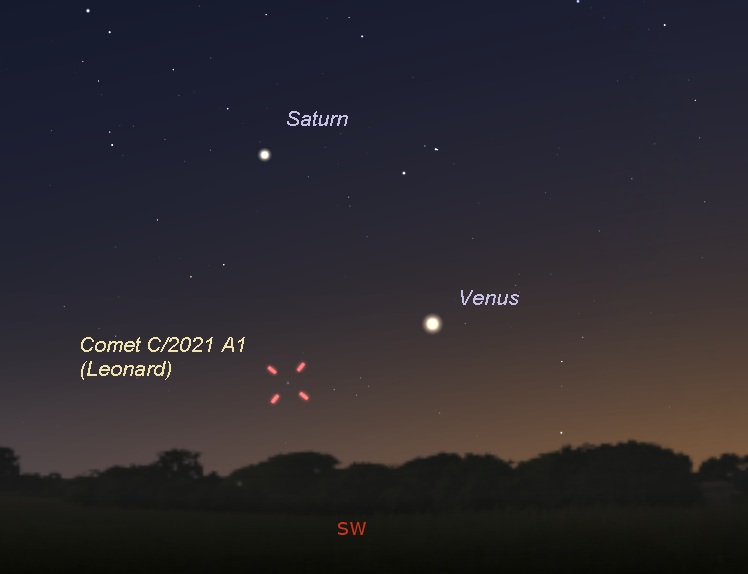

We wait with bated lens and telescopes to see what Leonard’s next move will be.Ĭomet Leonard races across Serpens and into Ophiuchus during its last mornings of visibility before transitioning into evening twilight.Īs the comet is now quickly approaching both the Earth and the Sun, it’s speeding faster across the sky. Contrariwise, forward scattering from cometary dust, as discussed in this previous article, could temporarily pump up its brightness and guarantee a naked-eye view. Should the nucleus break apart due to solar heating or other forces, it could experience a modest outburst and then fade rapidly.

Keep a close eye on Leonard on as many mornings as possible. With averted vision you may glimpse a degree or more of faint tail pointing upward to the northwest.

#Comet leonard stellarium Patch
Assuming its nucleus hangs together, binoculars should reveal the coma as a soft patch of light, brighter toward the center, about half the Moon’s apparent diameter. It’s even possible that something of the sort is happening right now with Leonard - after steadily brightening, it has recently shown signs of plateauing. Solar heating vaporizes the ice, creating pressures within and without the comet’s body that can sometimes disrupt it, tearing it apart. Composed of fragile honeycombs of ices both exotic and familiar, they sometimes break apart when nearing the Sun. What will we see? Comets can be tricky to predict because they have a penchant for unpredictability. Fortunately, the Moon will be around new phase and not a concern.Ĭomet Leonard crosses through Boötes and Serpens in the upcoming week. Use this light pollution map to help you locate the best spot in your city or region. You’ll see it best with a pair of binoculars or a telescope from locations with a dark eastern sky. That also happens to be the the date, give or take, that it will succumb to the glare of morning twilight low in the eastern sky. While Comet Leonard won’t compare to the splendor of last July’s Comet NEOWISE, it’s likely to become faintly visible with the unaided eye from a dark sky within a few days of December 12th. Three weeks prior, on December 12th, it will pass nearest the Earth at a distance of 21.7 million miles (34.9 million km). Since then, it’s inched steadily closer to both the Sun and Earth and will reach perihelion - closest approach to the Sun - on January 3, 2022. Lemmon Observatory near Tucson, Arizona, discovered the comet on January 3, 2021, when it was little more than a faint, distant speck. Senior research specialist Greg Leonard at the Mt. Its position is shown for December 12th, when it comes closest to the Earth. for a brief spin around the inner solar system before returning to this frozen fastness. Now it's faded out and am unable to spot it (6:58pm IST).Īny one else, from this part of the earth spotted it.Comet Leonard’s orbit takes it out to the Oort Cloud, a roughly spherical repository of billions of comets that orbits the Sun out to nearly a quarter the distance to the Alpha Centauri star system. I pointed by Orion 4.5 inch reflector at it and could see the 'nucleus'. But as the object moved towards east, it's brightness reduced. But it is fast moving and was very bright in twilight. But the tail was pointing towards the Sun (that makes me doubt if it is a comet). I was setting up to watch comet Leonard, when we observed a fast moving comet like object (nucleus, coma and tail), moving from near Fomalhaut towards Eridanus (6:30PM IST to now). Verzonden: zaterdag 25 december 2021 14:29Īan: Fast moving comet like object You might have seen the JWST launch vehicle, or a part of *Namens *Sajith via groups.io On 15:06, David Daelman via groups.io wrote: Maybe, but I would need the geographic coordinates and a scetch of the motion at the sky with stars and times.Ī brightness number would be also helpful On Saturday, December 25th, 2021 at 2:24 PM, Jost Jahn wrote:


 0 kommentar(er)
0 kommentar(er)
